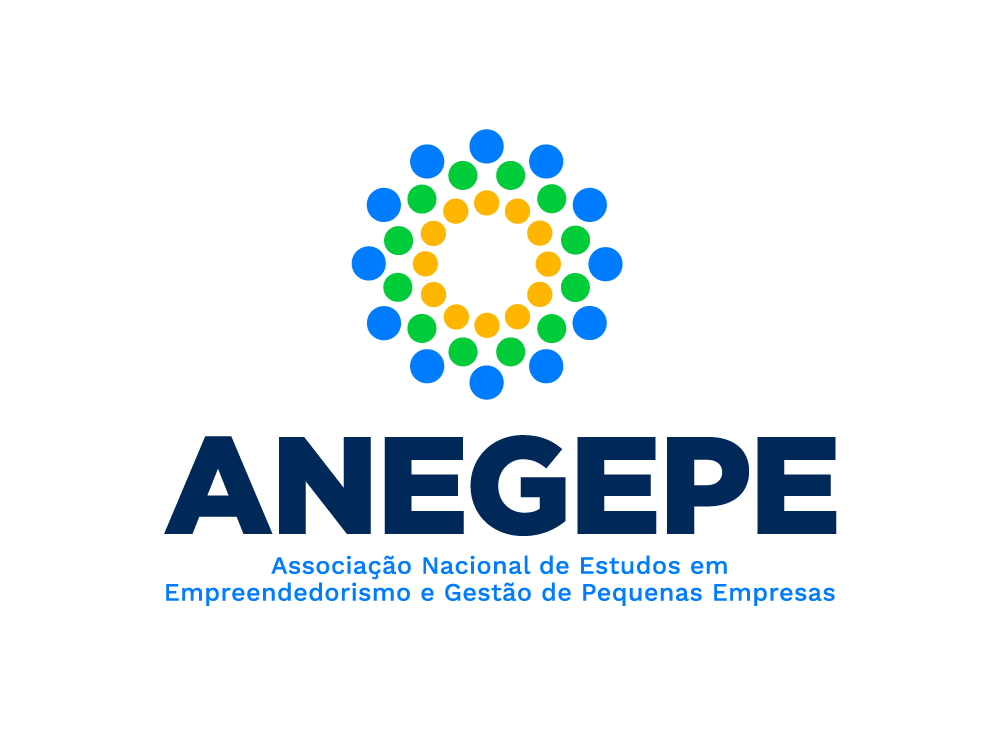A capacidade absortiva e a difusão da inovação em NEBTs e startups: Um estudo no Distrito Federal brasileiro
DOI:
10.14211/regepe.esbj.e2238Palavras-chave:
Capacidade absortiva, Inovação, Difusão tecnológica, Startups, Novas empresas de base tecnológicaResumo
Objetivo: Verificar a contribuição da Capacidade Absortiva (ACAP) para a difusão da inovação em Novas Empresas de Base Tecnológica (NEBTs) e startups estabelecidas no Distrito Federal brasileiro. Método: Estudo de entrevistas em profundidade com 20 empreendimentos inovadores, 12 (doze) startups e 8 (oito) NEBTs. Os resultados discutem dois itens de análise: Análise do perfil dos empreendimentos e a Análise da Classificação Hierárquica Descendente (CHD) e de conteúdo, em uma perspectiva comparativa acerca de 14 categorias temáticas. Resultados: Observou-se que fatores de desenvolvimento do Potencial da Capacidade Absortiva (PACAP) atuam como antecedentes da difusão da inovação. Já os fatores relacionados à Capacidade Absortiva Realizada (RACAP) estão envolvidos diretamente com a difusão da inovação, com destaque para a capacidade de gerar resultados de inovação por meio de canais de introdução mercadológica, adoção de novas tecnologias e investimentos financeiros. Contribuições teóricas/metodológicas: O estudo contribui para o campo teórico, ainda carente de produção especialmente regional, sobre a relação entre os construtos investigados no contexto de empreendimentos inovadores. Mecanismos de apoio, podem obter insights para aprimorarem o suporte oferecido que facilitem o acesso ao conhecimento a ser absorvido para sua conversão em inovações. Relevância/originalidade: A pesquisa amplia a compreensão da relação entre a ACAP e a difusão da inovação, envolvendo a absorção de conhecimento e a dinâmica destes construtos por meio de fatores críticos em contextos específicos ainda pouco investigados, como nas NEBTs e startups envolvendo ecossistemas regionais de inovação. Contribuições gerenciais/sociais: A investigação empírica e fatores abordados fornecem possíveis implicações gerenciais para práticas dos próprios empreendimentos ao desenvolverem inovações, bem como para o planejamento, desenvolvimento ou para o fortalecimento de ambientes e políticas de apoio.
Downloads
Referências
ABStartups - Associação Brasileira de Startups. (2019). Associação Brasileira de Startups: Mapeamento de Comunidades região Centro-Oeste. https://abstartups.com.br/mapeamento-Centro-Oeste/
Anatoliivna, V. O. (2013). Absorptive capacity in organizational theories: Learning, innovation, managerial cognition. Marketing & Management of Innovations, 4, 190-199. https://doi.org/10.21272/mmi.2013.4-18
Aribi, A., & Dupouët, O. (2015). The role of organizational and social capital in the firm’s absorptive capacity. Journal of Knowledge Management, 19(5), 987-1006. https://doi.org/10.1108/JKM-05-2015-0169
Bardin, L (1977). Análise de conteúdo. Lisboa: Edições.
Barnett, J., Vasileiou, K., Djemil, F., Brooks, L., & Young, T. (2011). Understanding innovators' experiences of barriers and facilitators in implementation and diffusion of healthcare service innovations: A qualitative study. BMC Health Services Research, 11(1), 342-342. https://doi.org/10.1186/1472-6963-11-342
Benson, D., & Ziedonis, R. H. (2009). Corporate Venture Capital as a Window on New Technologies: Implications for the Performance of Corporate Investors When Acquiring Startups. Organization Science, 20(2), 329-351. https://doi.org/10.1287/orsc.1080.0386
Blank, S., & Dorf, B. (2012). The step-by-step guide for building a great company. Pescadero, Calif: K&S Ranch, Inc.
Burcharth, A. L. L. A., Lettl, C., & Ulhøi, J. P. (2015). Extending organizational antecedents of absorptive capacity: Organizational characteristics that encourage experimentation. Technological Forecasting and Social Change, 90, 269-284. https://doi.org/10.1016/j.techfore.2013.12.024
Camargo, B. V. (2005). ALCESTE: Um programa informático de análise quantitativa de dados textuais. In A. S. P. Moreira, B. V. Camargo, J. C. Jesuíno, & S. M. Nóbrega (Eds.), Perspectivas teórico-metodológicas em representações sociais (pp. 511-539). João Pessoa, PB: Editora da Universidade Federal da Paraíba.
Camargo, B. V., & Justo, A. M. (2013). IRAMUTEQ: um software gratuito para análise de dados textuais. Temas em Psicologia, 21(2), 513-518. https://doi.org/10.9788/TP2013.2-16
Camisón, C., & Forés, B. (2010). Knowledge absorptive capacity: New insights for its conceptualization and measurement. Journal of Business Research, 63(7), 707-715. https://doi.org/10.1016/j.jbusres.2009.04.022
Chung, D., Jung, H., & Lee, Y. (2021). Investigating the relationship of high-tech entrepreneurship and innovation efficacy: The moderating role of absorptive capacity. Technovation, 111, 102393. https://doi.org/10.1016/j.technovation.2021.102393
Cohen, W., & Levinthal, D. (1990). Absorptive Capacity: A New Perspective on Learning and Innovation. Administrative Science Quarterly, 35(1), 128-152. https://doi.org/10.2307/2393553
Cuvero, M., Granados, M. L., Pilkington, A., & Evans, R. D. (2019). The effects of knowledge spillovers and accelerator programs on the product innovation of high-tech startups: A multiple case study. IEEE Transactions on Engineering Management, 1-14. https://doi.org/10.1109/TEM.2019.2923250
Dabic, M., Vlacic, E., Ramanathan, U., & Egri, C. P. (2020). Evolving absorptive capacity: The mediating role of systematic knowledge management. IEEE Transactions on Engineering Management, 67(3), 783-793. https://doi.org/10.1109/TEM.2019.2893133
Deeds, D. L. (2001). The role of P&D intensity, technical development and absorptive capacity in creating entrepreneurial wealth in high technology startups. Journal of Engineering and Technology Management, 18(1), 29-47. https://doi.org/10.1016/S0923-4748(00)00032-1
Flechas Chaparro, X. A., Kozesinski, R., & Salles Camargo Júnior, A. (2021). Absorptive capacity in startups: A Systematic literature review. Journal of Entrepreneurship, Management and Innovation, 17(1), 57-95. https://doi.org/10.7341/20211712
Flor, M. L., Cooper, S. Y., & Oltra, M. J. (2017). External knowledge search, absorptive capacity and radical innovation in high-technology firms. European Management Journal, 1-12. https://doi.org/10.1016/j.emj.2017.08.003
Fontanella, B. J. B., Luchesi, B. M., Saidel, M. G. B., Ricas, J., Turato, E. R., & Melo, D. G. (2011). Amostragem em pesquisas qualitativas: proposta de procedimentos para constatar saturação teórica. Cadernos de Saúde Pública, 27(2), 388-394. https://doi.org/10.1590/S0102-311X2011000200020
Fukugawa, N. (2013). University spillovers into small technology-based firms: channel, mechanism, and geography. Journal of Technology Transfer, 38(4), 415-431. https://doi.org/10.1007/s10961-012-9247-x
Garengo, P. (2019-2018). How bridging organisations manage technology transfer in SMEs: An empirical investigation. Technology Analysis & Strategic Management, 31(4), 477-491. https://doi.org/10.1080/09537325.2018.1520976
Ho, H., Osiyevskyy, O., Agarwal, J., & Reza, S. (2020). Does ambidexterity in marketing pay off? The role of absorptive capacity. Journal of Business Research, 110, 65-79. https://doi.org/10.1016/j.jbusres.2019.12.050
Hötte, K. (2020). How to accelerate green technology diffusion? directed technological change in the presence of coevolving absorptive capacity. Energy Economics, 85, 104565. https://doi.org/10.1016/j.eneco.2019.104565
Hughes, P., Hodgkinson, I. R., Hughes, M., & Arshad, D. (2017). Explaining the entrepreneurial orientation–performance relationship in emerging economies: The intermediate roles of absorptive capacity and improvisation. Asia Pacific Journal of Management, 1-29. https://doi.org/10.1007/S10490-017-9539-7
Jantunen, A. (2005). Knowledge‐processing capabilities and innovative performance: an empirical study. European Journal of Innovation Management, 8(3), 336-349. https://doi.org/10.1108/14601060510610199
Kato, M. (2020). Founders’ human capital and external knowledge sourcing: Exploring the absorptive capacity of startup firms. Economics of Innovation and New Technology, 29(2), 184-205. https://doi.org/10.1080/10438599.2019.1598670
Larrañeta, B., Galán González, J. L., & Aguilar, R. (2017). Early efforts to develop absorptive capacity and their performance implications: differences among corporate and independent ventures. The Journal of Technology Transfer, 42(3), 485-509. https://doi.org/10.1007/s10961-016-9488-1
Li, Y., Youtie, J., & Shapira, P. (2015). Why do technology firms publish scientific papers? The strategic use of science by small and midsize enterprises in nanotechnology. The Journal of Technology Transfer, 40, 1016. https://doi.org/10.1007/s10961-014-9391-6
Lindelöf, P., & Löfsten, H. (2003). Science park location and new technology-based firms in Sweden–implications for strategy and performance. Small Business Economics, 20(3), 245-258. https://doi.org/10.1023/A:1022861823493
Luo, B. N., Lui, S. S., & Kim, Y. (2017). Revisiting the relationship between knowledge search breadth and firm innovation: A knowledge transfer perspective. Management Decision, 55(1), 2-14. https://doi.org/10.1108/MD-07-2015-0327
Malik, K., & Wei, J. (2011). How external partnering enhances innovation: evidence from Chinese technology-based SMEs. Technology Analysis & Strategic Management, 23(4), 401-413. https://doi.org/10.1080/09537325.2011.558398
Marcon, A., & Ribeiro J. L. D. (2021). How do startups manage external resources in innovation ecosystems? A resource perspective of startups’ lifecycle. Technological Forecasting and Social Change, 171, 120965. https://doi.org/10.1016/j.techfore.2021.120965
Mason, G., Rincon-Aznar, A., & Venturini, F. (2020). Which skills contribute most to absorptive capacity, innovation and productivity performance? Evidence from the US and Western Europe. Economics of Innovation and New Technology, 29(3), 223-241. https://doi.org/10.1080/10438599.2019.1610547
Motohashi, K. (2005). University–industry collaborations in Japan: The role of new technology-based firms in transforming the National Innovation System. Research Policy, 34:, 583-594. https://doi.org/10.1016/j.respol.2005.03.001
Nooteboom, B., Van Haverbeke, W., Duysters, G., Gilsing, V., & Van den Oord, A. (2007). Optimal cognitive distance and absorptive capacity. Research Policy, 36(7), 1016-1034. https://doi.org/10.1016/j.respol.2007.04.003
Mueller, P. (2007). Exploiting entrepreneurial opportunities: The impact of entrepreneurship on growth. Small Business Economics, 28(4), 355-362. https://doi.org/10.1007/s11187-006-9035-9
Rogers, E. M. (1983). Diffusion of innovations. New York: The Free Press.
Rothaermel, F. T., & Thursby, M. (2005). University–incubator firm knowledge flows: assessing their impact on incubator firm performance. Research Policy, 34(3), 305-320. https://doi.org/10.1016/j.respol.2004.11.006
Salviati, M. (2017). Manual do Aplicativo Iramuteq (versão 0.7 Alpha 2 e R Versão 3.2.3). http://www.iramuteq.org/documentation/fichiers/manual-do-aplicativo-iramuteq-par-maria-elisabeth-salviati
Sebrae - Serviço Brasileiro de Apoio às Micro e Pequenas Empresas (2019). Confira as diferenças entre microempresa, pequena empresa e MEI. https://www.sebrae.com.br/sites/PortalSebrae/artigos/entenda-as-diferencas-entre-microempresa-pequena-empresa-e-mei,03f5438af1c92410VgnVCM100000b272010aRCRD
Serrano-Bedia, A. M., López-Fernández, M. C., & García-Piqueres, G. (2012). Complementarity between innovation activities and innovation performance: Evidence from Spanish innovative firms. Journal of Manufacturing Technology Management, 23(5), 557-577. https://doi.org/10.1108/17410381211234408
Sheng, M. L., & Chien, I. (2016). Rethinking organizational learning orientation on radical and incremental innovation in high-tech firms. Journal of Business Research, 69(6), 2302-2308. https://doi.org/10.1016/j.jbusres.2015.12.046
Souza, M. A. R., Wall, M. L., Thuler, A. C. M. C., Lowen, I. M. V., & Peres, A. M. (2018). O uso do software IRAMUTEQ na análise de dados em pesquisas qualitativas. Revista da Escola de Enfermagem da USP; 52. http://dx.doi.org/10.1590/S1980-220X2017015003353
Teigland, R., Gangi, P. M., Flåten, B., Giovacchini, B., & Pastorino, N. (2014). Balancing on a tightrope: Managing the boundaries of a firm-sponsored OSS community and its impact on innovation and absorptive capacity. Information and Organization, 24(1), 25-47. https://doi.org/10.1016/j.infoandorg.2014.01.001
Ubeda, F. M., Ortiz-de-Urbina-Criado, M., & Mora-Valentín, E. (2019). Do firms located in science and technology parks enhance innovation performance? The effect of absorptive capacity. The Journal of Technology Transfer, 44(1), 21-48. https://doi.org/10.1007/s10961-018-9686-0
Veugelers, R., & Cassiman, B. (1999). Make and buy in innovation strategies: evidence from Belgian manufacturing firms. Research Policy, 28(1), 63-80. https://doi.org/10.1016/S0048-7333(98)00106-1
von Briel, F., Schneider, C., & Lowry, P. B. (2019). Absorbing Knowledge from and with External Partners: The Role of Social Integration Mechanisms. Decision Science, 50(1), 7-45. https://doi.org/10.1111/deci.12314
Wang, Z., Wang, Q., Zhao, X., Lyles, M. A., & Zhu, G. (2016). Interactive effects of external knowledge sources and internal resources on the innovation capability of Chinese manufacturers. Industrial Management & Data Systems, 116(8), 1617-1635. https://doi.org/10.1108/IMDS-10-2015-0412
Yang, D., Li, L., Jiang, X., & Zhao, J. (2019). The fit between market learning and organizational capabilities for management innovation. Industrial Marketing Management, 86, 223-232. https://doi.org/10.1016/j.indmarman.2019.12.007
Zahra S. A., & George, G. (2002). Absorptive capacity: a review, reconceptualization, and extension. Academy of Management Review, 27, 185-203. https://doi.org/10.2307/4134351
Zheng, Y., Liu, J., & George, G. (2010). The dynamic impact of innovative capability and inter-firm network on firm valuation: A longitudinal study of biotechnology startups. Journal of Business Venturing, 25(6), 593-60. https://doi.org/10.1016/j.jbusvent.2009.02.001

Downloads
Publicado
Métricas
Visualizações do artigo: 1577 pdf downloads: 230 Viewer (xml, epub, html) downloads: 0 Mobile downloads: 0
Como Citar
Edição
Seção
Licença
Copyright (c) 2023 Bruno Alencar Pereira, Josivania Silva Farias

Este trabalho está licenciado sob uma licença Creative Commons Attribution 4.0 International License.
Autores que publicam nesta revista concordam com os seguintes termos:
- O(s)/A(s) autor(es)/autora(s) autorizam a publicação do texto na revista;
- A revista não se responsabiliza pelas opiniões, ideias e conceitos emitidos nos textos, por serem de inteira responsabilidade de seus autores/autoras;
- Autores/autoras mantêm os direitos autorais e concedem à revista o direito de primeira publicação, com o trabalho publicado sob a Licença CC BY 4.0
, que permite o compartilhamento do trabalho com reconhecimento da autoria e publicação inicial nesta revista;
- Autores/autoras são permitidos e encorajados a postar seu trabalho (Versão submetida, Versão aceita [Manuscrito aceito pelo autor/autora] ou Versão publicada [Versão do registro]) online, por exemplo, em repositórios institucionais ou preprints, pois isso pode levar a trocas produtivas, bem como a citações anteriores e maiores de trabalhos publicados. A REGEPE pede como condição política para os autores/autoras que indiquem/vinculem o artigo publicado com DOI. Veja o Efeito do Acesso Livre.














